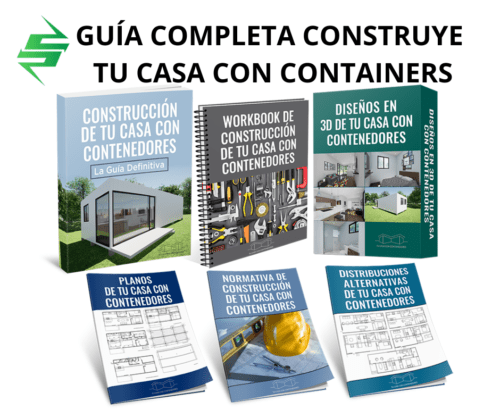Container modification requires tools for cutting containers and materials to effectively and efficiently transform a container into the perfect home. Whether you’re designing the house yourself or hiring professionals, understanding some of the metalwork involved is essential to grasp the modification process.
Features of Tools for Cutting Containers
Container modification is a significant undertaking, much like building a house. Installing windows, doors, ventilation ducts, and other spacing options requires cutting, trimming, or shaping steel.
Containers, having the strongest type of steel known as corten steel, demand powerful tools made with the most durable materials to withstand the pressure. Let’s explore the qualities of the tools needed for this job.
The Material Base of Cutting Tools
The material of the cutting tools to be used must be strong enough to withstand the high temperatures generated by the cutting force. Their hardness rating should be of the highest level to ensure they don’t break during the job.
The tool’s material should have high melting points and non-reactive materials to the chemicals they’ll come into contact with. With high hardness, strength, and heat resistance, the ideal tool for the job should be at least 1.5 times the normal cutting parameters.
Coated tools can also be used if they exhibit qualities of resistant and durable materials. The only downside with them is that they don’t easily sharpen once they lose their edge.
The best tool materials for the job could be:
- Ceramic
- Cubic boron nitride
- High-speed steel
- Diamond
- Tungsten carbide
Cutting Tools
Now that you understand the material base of the tools you’re seeking, let’s get into it. Cutting tools come in different shapes, sizes, and uses. In engineering terms, they are generally classified into types for easy distinction by their wedge shape and the work they perform.
Here are the types of tools used during the transformation process:
- Milling cutter
- Drill
- Shaper
- Fly cutter
- Planer
- Boring bar
- Reamer
- Countersink cutter
- Broach
- Grinding wheel
All these tools serve a specific purpose in the process, as discussed below. But first, let’s understand the purpose of these tools. Here is the classification of cutting tools.
Classification of Cutting Tools
- Single-point cutting tool: It has a single cutting edge and performs only one task at a time. Examples include the fly cutter, boring bar, and slotting tool.
- Double-point cutting tool: With two cutting edges, this tool can perform two tasks simultaneously. Like the cutting drill used for drilling through steel.
- Multi-point cutting tool: This is a tool that contains more than two primary cutting edges that can remove material simultaneously in a single pass. Examples include end mills, broaches, gear cutters, and abrasive wheels.
With that in mind, let’s dive straight into the main agenda. Containers have a lot of work to do to provide a sophisticated home.
Most Common Tools
- Welding tools
- Metal cutting tools
- Plasma cutter
Let’s take a look at each of them.
Welding Tools
This is one of the most important tools used in container conversion due to its versatile nature. They can perform various tasks necessary for the entirety of the job.
These include:
- Joining two or more containers.
- Adding a structural element to the container.
- Combining the container with the house using steel beams used for foundations.
- Welding to add frames to windows and doors.
Types of Welding Tools There are different types of welders used for different purposes around and on the container.
- Oxy-fuel welder
To begin with, Oxy-fuel welding. It goes by different names depending on your country or state. But they operate through inert gases and liquid fuels like gasoline to provide them with powerful assistance in metal cutting and shaping.
Oxy-fuel welding involves using a welding torch to burn the metal, creating molten metal that combines the metal’s troublesome sides into one. Similar to what happens during the creation of metal doors or beds.
When the oxy-fuel machine is used to cut metals, the torch will also heat the metal to produce oxygen. Combined with oxygen, the metal forms a metallic oxide that then flows like a slow liquid. Easily penetrated.
In cases where welding is done without the combined oxygen and fuel torch, it’s only called a single-tank torch. This will be used for simpler tasks like soldering or welding as they can’t weld effectively.
- Metal inert gas (MIG) welder
Also known as MIG, this welder uses a wire spool similar to wire-fed welders as its continuous electrode. It will be combined with external shielding gas to enhance the intensity of welding.
They are better for clean paint jobs, but they struggle to cut metal unless it’s coated or double-hardened for the job, making them more expensive.
- Tungsten inert gas (TIG) welder
Using a non-consumable tungsten rod, this welder uses both shielding gas and a filler rod to properly conduct heat for welding. The work done by this welder is quite more intense and requires the use of both hands.
It also performs better under clean and smoothly painted containers.
- Gas metal arc welding (GMAW)
Uses certain gases to break or weld metal parts. Not as powerful as tungsten, but they provide considerable help in welding.
- Flux-cored wire welder
This welder uses a strong flux-cored wire spool to continuously serve as an electrode. Working similarly to MIG, these wire-fed welders are relatively easy to use. They don’t cause splatters during the process, thus producing clean work.
They can be expensive to use even though they don’t offer as much welding support as others.
- Stick welder
Using consumable electrodes, this type of welder is quite simple and straightforward to use even for beginners. It requires a constant change of electrodes as it’s not strong enough to weld large areas for a long time.
Being basic, it’s not recommended for large construction areas, but it’s favorable for unclean metals, as it doesn’t adhere to the metal during welding.
- Shielded metal arc welding (SMAW) and tungsten inert gas (TIG) arc welder
Both are used for welding lighter surfaces of the container, such as window frames and door hinges. Not suitable for old and rusty metals as they don’t have that much power.
Metal Cutting Tools
Very common tools. Specifically used for cutting metal. They are necessary for making openings in the cooling container, so they’re quite essential for any modification task.
Just like welding tools, these metal cutting tools also come in types. While they all cut something, they offer cutting services in different areas. They include:
- Angle grinder
- Cutting torch
- Plasma cutter
Angle Grinder
Very simple, very affordable, these cutting tools are highly versatile and useful for any work under container homes. Their only task is to replace cutting discs, but otherwise, they’re very convenient.
The weight is particularly heavy compared to other tools and it’s very loud and messy. Messy in the sense that, due to the force it exerts on the work, gyroscopic is also released, creating sparks that could be harmful to the naked eye and ear.
Plasma Cutter
Using heat, the plasma cutter will cut any conductive metal, including copper, aluminum, brass, and any variant of steel. Quite common in hardware stores and auto shops, this cutter is also fairly easy to use.
There are different types of plasma cutters, including handheld devices that offer great technique and control. Also known as handheld torches, they can cut thick materials over 1.5 inches thick regardless of the metal material.
As for other types of plasma cutters, there’s the CNC cutter mainly used for decorative cuts. Using the same technique as laser cutting, the plasma cutter will instigate decorative patterns on walls.
Cutting Torch
Very similar to the plasma cutter, this torch uses substantial amounts of heat to cut metal. Based on a machine, it can also generate sparks and cause a lot of noise while cutting metal.
If you want to differentiate this and the welding torch, look at the explosive nozzle. This cutting torch has a different and more defined trigger and lever compared to the welder’s. The cutting process begins by heating the metal until a change of color is noticed. It’s usually bright red.
At this point, oxygen will be pressed into the area to allow gas mixing. The blast trigger will then mix the oxygen and metal to form a metallic oxide that then allows more heat to pass through the surface. Additional heat could be used for any further cutting.
Working alongside the grinder, once heat and oxygen have combined with the metal to form slag, you can now easily use the grinder for any additional cutting.
Other Cutting Tools
In addition to the most common types used for containers, there are other complementary ones that can be used for one or two purposes. These cutting tools include:
- Milling cutter
- Broaching for metalworks
Milling Cutter
Also known as a countertop cutter, they come in different shapes and sizes, including helixes, flutes, and teeth. With incredible polycrystalline diamond coatings, they can easily drill through corten steel.
There are different types of cutters available for use during the process. There’s one that can grind with a rough finish and others that offer excellent finishes. The roughing cutter has a sharp but serrated edge used to break down materials into smaller pieces.
The finishing cutter is used to smooth the surface with the grooves, which could also cause a chip problem where there’s a buildup of dirt from metal work. However, this cutter isn’t appropriate for larger or thicker material.
Metalworking Broaching
Another metalworking involved is called broaching. It’s not common for use with container work, but it can be used. It involves the use of a serrated tool known as a broach to finish any irregular cuts made by the previous cutting tools.
There are two types of broaching:
- Linear: It’s a straight repeat cut to make it more precise and uniform. Similar to a finishing cut.
- Rotary: Involves rotating and pressing the metal structure to cut towards a specific asymmetrical shape. This type is used as a feed tool for a screw machine to make more efficient cuts.
When making cuts on containers, some areas require precision, probably due to balance or design factors. This is where broaching comes into play. It can be used to create odd shapes like circular or non-circular holes, slots, keyways, or flat surfaces.
A disadvantage of broaching is that it’s quite expensive, both the tool and the process. As such, not many people would want to use them as container homes are a low-cost housing solution.
Best of luck
Each of these tools plays a significant role in the modification process. While some provide rough cuts, others are precise and delicate for the task.
You’ve learned about the basic tools used for making cuts on a container. It should be an easy process even if you do it yourself. But it’s always better to involve engineers or professional technicians to do the job for you.
This content is accurate and true to the best knowledge of the author and is not intended to substitute for formal and individualized advice from a qualified professional. Please leave me a comment!
 MAS INFORMACIÓN CLIC AQUÍ Construye Tu Casa con Contenedores Paso a Paso
MAS INFORMACIÓN CLIC AQUÍ Construye Tu Casa con Contenedores Paso a Paso  MAS INFORMACIÓN CLIC AQUÍHágalo Usted Mismo Construye Tu Casa con Contenedores Paso a Paso
MAS INFORMACIÓN CLIC AQUÍHágalo Usted Mismo Construye Tu Casa con Contenedores Paso a Paso



